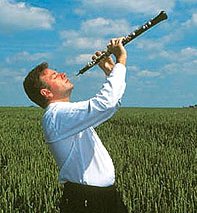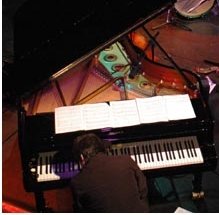In the second concert of the Keys to the Future series, Tatjana Rankovich, organizer Joseph Rubenstein, and Lora Tchekoratova performed in a program rich in compelling melodic and textural content.
Music for Piano (1997) Franghiz Ali-Zadeh (b. 1947)
Tatjana Rankovich began the program on a piano with a beaded necklace inside. Middle Eastern vocal melodies caused this necklace to resonate in a pleasant (if ultimately obsessive) almost insectoidal buzzing. Occasional outbursts in the lower ranges contrasted with these exquisite Eastern melodies ultimately climaxing in a storm of bass scales. Ms. Rankovich notably performed with precision and a finely atuned sense of the vocal quality of the melodies in Music for Piano.
Éphémères (4 selections) (2003) Philippe Hersant (b. 1948)
Philippe Hersant is practically unkown in the U.S. and apparently (thanks to not being a Boulezian) not quite as well known as he should be in France. Ms. Rankovich performed 4 pieces from his 24 piece cycle, Éphémères inspired by haiku by Basho. Of particular interest was the tempestuous ‘Ouragan’. Scalar motives in the bass exploded into often brilliant gales of color and rhythmic excitement. Rankovich evocatively drove the hurricane like a savage god. ‘Vallee du sud’ called forth memories of the bell-like sonorities of Debussy but with a personal and extended melodic touch that did not feel to be foreign to the style. Hersant is definitely a composer that should be much more widely known outside of France.
Brin (1990) Luciano Berio (1925-2003)
Brin is a wonderful miniature and utilized Berio’s signature rapid scalar figurations to interrupt a static and jewel-like sound world. Rankovich performed Brin with marvelous microscopic abandon.
Fifth Romance (1984) Joseph Fennimore (b. 1940)
Fennimore’s Fifth Romance attempted to combine jazz, show tune pianisms and Scriabinesque harmonies to mixed effect. The romance was never confusing and often surprising, but I was left feeling that parts of this feast of romantic moods were undigested. Nonetheless it was a remarkably executed composition and its exposed origins evinced an immense technical imagination. Tatjana Rankovich performed with intelligent pizzazz this stylistically exposed composition.
Nocturne No. 5 (1996) (Tchekoratova) Lowell Liebermann (b. 1961)
Bulgarian pianist, Lora Tchekoratova continued the program with Nocturne No. 5, a piece obviously influenced by Chopin and Scriabin although updated to varying degrees harmonically and melodically. It was voiced with marvelous delicacy and precision by Tchekoratova. Some of the harmonic shifts were not always convincing, but the clarity of the upper lines propelled the piece to good effect.
Mambo No. 1 (2006) Phil Kline (b. 1953)
Phil Kline’s piece was an exciting post-minimalist/totalist extravaganza of sections, each one exploding into the next. Often, as the section climaxed, complex rhythmic indulgences seemed to interfere with the emotional crescendi underway. I was left feeling that the piece was a bit self-indulgent although interesting in its compellingly brilliant material.
Rain Tree Sketch II (1992) Toru Takemitsu (1930-1996)
Takemitsu’s brilliant extensions of the pianistic language of Debussy and Messiaen is under-recognized. Rain Tree Sketch was performed to scintillating and fluidic effect by Tchekoratova. Chords interrupted by dark octaves formed the primary textural motivations behind this wonderful compositiion.
Für Alina (1976) Arvo Pärt (b. 1935)
Concert organizer Joseph Rubenstein next performed Arvo Pärt’s uniquely fractured plainsongs to marvellously spiritual effect. In a lesser composer’s hands such repetition of texture and register would fall flat. It is only with Pärt’s singular mindset and commitment that the meditation unfolds so convincingly.
Exit Music for a Film (1998) Radiohead/Christopher O’Riley
The second of O’Riley’s Radiohead ‘transciptions’ could more accurately be qualified as a ‘paraphrase’. It was intensely compelling and performed with accurate and decadent flair by Joseph Rubenstein. A real testament to the group’s compositional talents is how, through these arrangements, the philosophical intensities are maintained.
Five Preludes (2003) Bruce Stark (b. 1956)
Bruce Stark’s music was performed to wonderful effect again in tonight’s program. His 5 short pieces further explored how jazz stylings and American folk music influences can be used without merely evoking the achievements of the ’50’s. The explosive 5th prelude was fascinating in how it simultaneously and without feelings of pastiche evoked both Bartok and Gershwin.
Tonight is the third and final night of the series featuring a mini-survey of recent Latin-American piano music, an angelic invocation by Stark, and one of Joseph Rubenstein’s own compositions. It looks to be a doozy!
 THE WEATHER RIOTS
THE WEATHER RIOTS This past Sunday 37,936 people ran 26.22 miles through parts of all five boroughs of New York City from Staten Island to Central Park, through parts of all five boroughs. The marathon has taken place on the first Sunday of November every year since 1970, and this year Jelena Prokopcuka won the women’s division with a time of 2:25:05, M. Gomes dos Santos won the men’s division clocking in at 2:09:58, and the wheelchair divisions male and female winners were Stephen Kiogora (2:10:06) and Paul Tergat (2:10:10).
This past Sunday 37,936 people ran 26.22 miles through parts of all five boroughs of New York City from Staten Island to Central Park, through parts of all five boroughs. The marathon has taken place on the first Sunday of November every year since 1970, and this year Jelena Prokopcuka won the women’s division with a time of 2:25:05, M. Gomes dos Santos won the men’s division clocking in at 2:09:58, and the wheelchair divisions male and female winners were Stephen Kiogora (2:10:06) and Paul Tergat (2:10:10).
 Tomorrow (Nov 6) soloist Nicholas Daniel (left) and the Britten Sinfonia give
Tomorrow (Nov 6) soloist Nicholas Daniel (left) and the Britten Sinfonia give  You don’t need to be a
You don’t need to be a 
